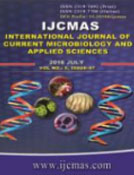


 National Academy of Agricultural Sciences (NAAS)
National Academy of Agricultural Sciences (NAAS)

|
PRINT ISSN : 2319-7692
Online ISSN : 2319-7706 Issues : 12 per year Publisher : Excellent Publishers Email : editorijcmas@gmail.com / submit@ijcmas.com Editor-in-chief: Dr.M.Prakash Index Copernicus ICV 2018: 95.39 NAAS RATING 2020: 5.38 |
Blastocystis infection has been reported to be associated with irritable bowel syndrome (IBS), inflammatory bowel disease (IBD) and chronic diarrhea. The availability of data on the subtypes of Blastocystis hominis found in these patient groups would be of interest in understanding the significance of Blastocystis infection in chronic illness. This study is a trial to identify Blastocystis subtypes among patients with IBS, IBD, chronic diarrhea and a symptomatic individual in Kirkuk/ Iraq. The results revealed that diarrhea due to Blastocystis infection were highly recorded among patients with IBS and IBD aging from 20 to 29 years using direct microscopy examination. In-vitro culturing reveal 104 of Blastocystis hominis stages (only 80 samples) were pure and harvested for DNA extraction. Whereas Conventional PCR employee from stool culture reveal positive for Blastocystis hominis bearing genomic masses ranged from 486 to 512 bps. An attempt for detecting the parasite subtypes using subtype 1, 3, 5, 7 was performed, and the following results were recorded: high rate 25 % of 53 positive samples from total of 80 samples was belongs to subtype 3 followed by 18.75 % for subtype 1.While for each subtype 5 and 7 only 11.25 % were recorded, P>0.05.Subtypes 3 and 1 where dominant among elderly patients with IBS and IBD. In a symptomatic individual no intestinal parasites including Blastocystis and no an excess Candidiasis were recorded. Relationship between patients' gender and Blastocystis distribution among gastrointestinal disorder (GID) patients was not significant; controversy to patient's ages which show high frequencies of Blastocystis hominis among patients aging from 41 to 80 years. Blastocystis hominis mostly coexisted with Giardia lamblia among patients with IBS, whereas Entamoeba histolytica was highly found among patients with IBD than in IBS patients. Conclusions: Direct microscopy is useful method for screening of Blastocystis hominis in stool samples of patients with GID, while culturing of feces has had great role in confirming positive cases of direct microscopy, parasite harvesting for molecular studies and drug monitoring. Polymerase chain reaction (PCR) is more accurate and precise technique for detecting subtypes of Blastocystis hominis. Further studies should be carried on in the same province using the remaining subtypes for detecting real etiology for blastocystiasis among GID patients.
 |
 |
 |
 |
 |